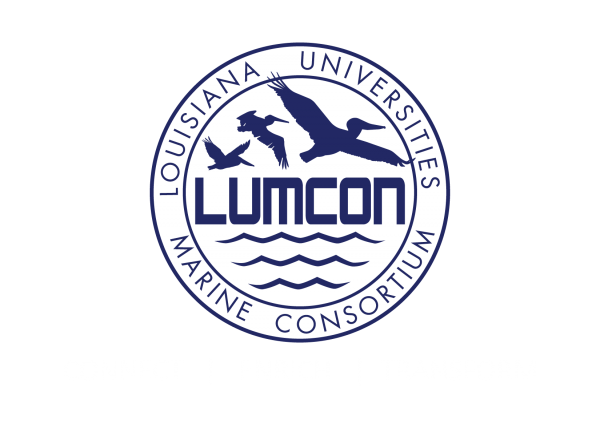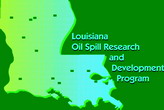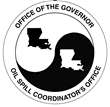LIBRARY
MAIN CATALOG (Electronic Resources/LUMCON Library)
Click here to search the Dispersants Bibliography
Click here to search Effects of Offshore Oil and Gas Development Bibliography
ABOUT THE LIBRARY
The LUMCON Library collection was originally housed in Ellender Memorial Library, located at Nicholls State University in Thibodaux, Louisiana. After completion of the DeFelice Marine Center in 1986, the collection was moved to its present location. Since that time, the Library has become an active resource center for LUMCON faculty and staff as well as Consortium member institutions, visiting researchers, students, and the public.
The library contains a computer lab and several study spaces available to visiting students, scientists, or groups (such as attendees of a writing retreat).
The collection and development of library materials reflects LUMCON’s research programs. The collection has approximately:
- 4,600 monographs
- 5,800 bound volumes
- 200 journal titles
- 26 current journal subscriptions
- 850 maps
- 35 atlases
- 3,600 government documents
- 1,500 reprints
In addition, the library houses a complete collection of research products generated by DeFelice Marine Center personnel since LUMCON’s inception.
HOURS OF OPERATION
- The LUMCON Library is staffed Monday through Friday from 7:00 AM to 3:30 PM. All visitors are welcome during these hours.
- The Library is closed to the public on weekends, state holidays, and when the librarian is not on site. Before visiting the facility, please call 985-851-2875 to ensure the Library will be open.
- All LUMCON staff, summer students, and resident visitors have 24-hour access to the Library. If the doors to the Library are locked, the security guard will open them for you.
CIRCULATION
- Books can be checked out by filling out a card at the circulation desk. The length of time a book can be checked out varies depending on the patron’s status. Books may be renewed by contacting the department, but all items are subject to recall at any time.
- Interlibrary loan service is available for LUMCON faculty, postdocs, lab personnel, and summer students. Although we strive to get items at no charge, the patron may be asked to pay for interlibrary loan charges under certain circumstances.
- Reserve items, reference materials, and journals must remain in the Library. The Library has no photocopier, but copies or scans can be made in the LUMCON main office.
- All materials must be checked out before removal from the Library, without exception.
- Library materials can be placed on reserve for summer classes. A list of items to be placed on reserve should be provided to the librarian as soon as possible.
- When returning material that has been checked out, please drop off items at the circulation counter.
Food is not allowed in the Library under any circumstance. Drinks are only allowed with prior approval by the librarian or the security guard.
INTERNSHIP PROGRAM
The LUMCON Library is available as an internship site for graduate-level students who have completed at least two semesters toward a Master’s degree in Library and Information Science. Applications will be accepted on a continuing basis and internships may be completed during any semester. Prior library experience or an undergraduate degree in science is desirable, but not necessary. Credits will be awarded based on the number of person-hours completed (40 person-hours per credit hour).
The internship will consist of both field experience, encompassing many operations of a special library, and a special project in technical services. The Librarian will give the intern an overview of reference services, technical services, library administration, and budgeting, and will guide the intern through special projects. The LUMCON Library uses SIRSI/Dynix’s Symphony Integrated Library System as well as OCLC for Cataloging/Interlibrary Loan services.
Contact the Librarian for more information or to apply for an internship.
ACKNOWLEDGMENTS
We would like to thank the following individuals for their guidance and input when creating the Dispersants Bibliography:
-
- Victoria Broje, Per Daling, Alun Lewis, and Francois-Xavier Merlin offered valuable assistance in the early phases of this project. Per Daling’s support was especially noteworthy, by providing conference proceedings that otherwise could not be obtained.
- Deborah Ansell, ITOPF’s librarian, contributed by sharing her sizeable list of library holdings on dispersant publications with us, and filling in gaps where existing citation information was incomplete.
- Likewise, Julie Anne Richardson, librarian for Environment Canada, compiled a publication listing on dispersants housed in her collection, which provided us with additional citations for our project.
- Qianxin Lin at Louisiana State University provided API conference proceedings for us to use in transcribing abstracts.
- Nancy Kinner at the Coastal Response Research Center provided encouragement, focus, and connected us with some of the aforementioned people.
- Finally, Don Davis and Karen Reeder Emory at OSRADP deserve special mention for all of their help and direction during the span of this project.
 |
 |
 |
The LUMCON Library is a member of the International Association of Aquatic and Marine Science Libraries and Information Centers (IAMSLIC), the Southeast Affiliate of IAMSLIC Libraries (SAIL), and the Louisiana Library Network and Information Consortium (LOUIS). Additionally, the Library has access to OCLC Cataloging/Interlibrary loan services.
Click here to search LUMCON’s e-Library catalog using the LOUIS portal.
DISPERSANTS BIBLIOGRAPHY
Over a three-year period (1995-1998), we studied short-term effects of dispersant use and a bioremediation strategy in two consecutive field trials in sub-tropical Australian mangroves. In each case, weathered oil was applied, and a large spill simulated, in mature Rhizophora stylosa trees around 4-9 m tall. In the first trial, we used Gippsland light crude oil with or without dispersant, Corexit 9527. In the second, a bioremediation strategy followed application of Gippsland oil or Bunker C fuel oil. Bioremediation involved forced aeration with supplemental application of nutrients. Dispersant use had an overall positive benefit shown as reduced tree mortality. By contrast, there was no apparent reduction in mortality of trees with bioremediation. However, one year after oiling, leaf densities of surviving trees were greater in bioremediation plots than in controls, and less in oil-only plots. These and other results have been incorporated into spill response management strategies in Australia
In this paper, the results of a 19 month investigation of microbial communities subjected to the effects of oil and oil plus dispersant additions in man made ponds are reported. Microbial biomass estimations by ATP (adenosine triphosphate) and microscopic procedures using epifluorescence indicated that oil and oil plus dispersants had little or no effect on these parameters, and any effect noted was stimulatory. However, detailed examination of specific populations indicated that oil and oil plus dispersant additions were stimulatory for short periods of time to the populations studied. Seven days after the oil and dispersant additions to the ponds, no mutagenic or toxic activities to bacteria were noted
Two experiments conducted in the mangrove swamp of the Mahakam delta (East Kalimantan, Indonesia) provided two years continuous study of the growth and mortality rates of Sonneratia caseolaris planted upon an oil-polluted substrate. These experiments have shown that the plants were at first submitted to a mortality phase which can be attributed to the intense toxicity of the oil. During the study period, the influence of the pollutant could be seen in the decrease in growth-rate of the surviving plants. These results are in proportion with the quantity of oil spilt, and vary according to the different treatments applied several days after pollution and before planting. Absence of treatment however gives better results on the mortality and growth of Sonneratia caseoralis
Two simulated oil-spills in the Mahakam Delta revealed the consequences of this type of pollution on the site's main benthic populations. The results of these trials differentiated between short-term (high toxicity similar to chemical pollution) and long-term effects (similar to organic pollution) of hydrocarbons. Two factors affected the distribution of the main macrofaunal species: intertidal height and degree of pollution. The latter was measured either by the initial quantity of oil spilled or by concentrations measured at each sampling. These trials also showed that dispersants were inefficient and that dredging treatments did not yield positive results. Often no treatment was preferable to these two treatments. A global statistical analysis was generated to define the role of the different environmental variables, both natural or pollution-related, in the spatial distribution of the different species
Using static bioassay procedures, crude oil plus a chemical oil dispersant were tested for toxicity to adults or juveniles of ten marine species: Heteroxenia fuscescens, Nerita forskali, Drupa granulate, Mytilus variabilis, Acanthopleura haddoni, Echinometra mathaei, Calcinus lateens, Palaemon pacificus, Parupeneus barberinus, and Siganus rivulatus. LC50 (168 h), ranged from 0.006 to 0.064 ml/liter for the dispersant. LC50 (168 h) values for oil/dispersant mixtures of 10:1 for selected species ranged from 0.047 to 0.152 ml/l which appears to reflect the biocidal properties of the dispersant. Some individuals surviving immersion in high concentrations of the test compounds were adversely affected both during and after treatment
Predation rate of the gastropod drill, Drupa granulate, on the mussel, Mytilus variabilis, was measured over a period of 28 days after adults from both ssp had been immersed for 168 hrs in seawater solutions containing high sublethal concentrations (10 ml/l) of Iranian crude oil. Predation rate was 3 times higher in controls than in the group where both predator and prey had been exposed initially; intermediate values were determined among groups where only 1 sp had been treated initially. Fecundity of drills, as evidenced by number of egg cases deposited, was directly related to mussel consumption. In a similar study with a chemical oil dispersant, exposure to high (0.003 ml/l) sublethal levels for 168 hrs did not affect markedly the rate at which mussels were destroyed an consumed during post-treatment. However, the fecundity of untreated drills feeding on untreated mussels (controls) was 3 to 10 times greater than among groups in which one or both ssp had been exposed initially to dispersant. Except for mussels consumed by drills, there were no deaths during the post-treatment period in either study, and all organisms appeared normal
This report studies the effects of crudes and a chemical oil counteractant on survival, metabolism, and behavior of representative species of Red Sea macrofauna under controlled environmental conditions. Specifically, it examines the action of crude oil from fields in Iran and in the Sinai, a chemical oil dispersals, and oil-dispersant mixtures on Red Sea juveniles or adults of octocorals, crutaceans, molluscs, echinoderms, and teleosts. The choice of bioassay methodology on response parameters, especially survival, was significant. A comparison of toxicity values derived from tests in large (1,500 l), deep (2.0m) tanks under conditions of continuous flow with those performed in small (3 l)jars under static conditions demonstrated that most assay spedies were up to 30 times more resistant to almost all toxicants in large tanks. Tank tests also demonstrated a protective effect with increasing depth: organisms confined to 1.0 to 1.8 m from the surface exhibited higher survival than those held at shallower depths. Sublethal and latent effects of oils and dispersants on Red Sea biota were reviewed and included reduction in feeding rate and egg case deposition of predatory gastropods, interference with substrate attachment by mussels, liver enlargement and lowered blood hematocrit values in fishes, and bioaccumulation of crude oils in octocorals. These and other data presented herein suggest that introduction of petroleum into Red Sea ecosystems may disrupt established feeding-predator patterns, reproductive processes, defense mechanisms, and conceivably other systems, and it would constitute a potential threat to population stability
LC50 values were determined for two crude oils, ST 5, a chemical oil dispersant, and oil/ST 5 mixtures in 10:1 vol/vol ratios. Static tests at 41‰ salinity and 23°C produced LC50 (168 h) values of 0.010 ml/l for ST 5, with LC50 values for oil ST 5 mixtures reflecting toxic properties of ST 5 alone. ST 5 exhibited a striking reduction in lethality after 2 hr in the assay medium. Elevated sublethal levels of ST 5 caused reductions in blood hematocrit. Rabbitfish were more resistant to pollutants in continuous flow bioassays in large tanks than static jar bioassays. Tank tests also resulted in higher mortality in stressed fish confined nearer the surface (to 1 meter) than those kept at lower depths (1 to 1.8 meters)
Acute toxicity to representative species of marine macrofauna of 2 common grades of crude oils, a chemical oil dispersant, and mixtures of oil and dispersant is summarized. Test animals were adults from locally abundant groups of coelenterates, molluscs, crustaceans, echinoderms, and juvenile teleosts. Both grades of crude oil were relatively innocuous when compared to the dispersant. Toxicity of oil dispersant mixtures reflected the biocidal properties of the dispersant alone. Fishes and crustaceans were among the most sensitive groups tested. Effect of time in the aerated assay medium on toxicity in high concentrations of Iranian crude oil, Sinai crude oil, and dispersant was also investigated, using the juvenile rabbitfish (Lagocephalus laevigatus). The surfactant fraction of the dispersant contained virtually all of the toxic properties. Continuous flow tank tests elucidated a depth protective effect. Sublethal and latent effects on the various fauna are also outlined
The compressibilities of crude oil/water interfaces have been measured for Brega, Kuwait and Tia Juana crude oils by an adaptation of the pendant drop method. Addition to the oils of a commercial dispersant (BP1100X) which contains an oil-soluble non-ionic surfactant resulted in increased compressibilities, the rate of increase with amount of BP1100X added being inversely related to the asphaltene content of the oils. The viscoelastic properties of the interfaces were studied with a surface rheometer working at low shearing stresses. Creep curves showed rapid elastic deformation and slow irrecoverable flow. The flow curves, which were irregular, indicated very high surface viscosities which appeared to increase with applied shear stress. It is suggested that thick films of asphaltene particles were responsible. The addition of 4% v/v BP1100X to the oils produced no effect for Kuwait and Tia Juana crudes, but Brega oil interfaces showed an increased elasticity. Interfaces formed between a dispersion of asphaltenes in n-heptane/toluene and water exhibited both rapid and retarded elasticities as well as Newtonian flow
In view of the increasing risk of oil pollution in tropical waters, experiments were carried out to assess the effect of various crude oils, an oil dispersant, and mixtures of these, on a coral dominant in the Curacao reefs; results are summarized in tables and graphs. The studies showed that the dispersant was more toxic than the oils, and it is recommended that such dispersants should be used only in the open sea; oil above coral reefs should be removed by mechanical methods, if possible with a minimum of mixing
The toxicity of two non-ionic oil-dispersing agents was determined on a number of marine species: the edible mussel Mytilis edulis, winter flounder, soft shell clam, mummichog, Atlantic silversides and fourth stage lobster larvae. The bioassay system used consisted of a series of storage reservoirs and exposure tanks with a total volume of 112 liters. Water movement was provided by a series of marine aquarium pumps which circulated water at a rate of 4 liters/min. Additional aeration was not required for the mummichog, mussel or fourth stage lobster larvae. At 20°C, TL50’s calculated from 24 to 96 hours fell between 30 and 75 mg/l, with no significant difference in toxicity between the two dispersants. At 5°C, toxicity in the mummichog was significantly lower; this may be explained by the accompanying higher oxygen levels. The advantages of the circulating aquarium system in relation to the static and continuous-flow bioassay systems are discussed
A number of experiments were carried out in the Canadian Arctic on Baffin Island with the purpose of defining the short- and long-term effects of exposure to dispersed crude oil on marine benthic invertebrates. The study reported here assessed metabolic responses by physiological and biochemical indices, and evaluated these in relation to exposure concentration. The overall objective of the study was to evaluate the potential for long-term survival of benthic communities in the Arctic following an oil spill. This objective was consistent with the goals of the larger Baffin Island Oil Spill (BIOS) program, which was implemented to evaluate the relative mitigating effectiveness of chemical dispersants, as compared to conventional oil spill counter-measures
Harmful effects of five third-generation oil dispersants (Inipol IP-90, Petrotech PTI-25, Bioreico R-93, Biosolve and Emulgal C-100) on planula larvae of the Red Sea stony coral Stylophora pistillata and the soft coral Heteroxenia fuscescense were evaluated in short-term (2-96 h) bioassays. Larvae were exposed to Egyptian oil water soluble fractions (WSFs), dispersed oil water accommodated fractions (WAFs) and dispersants dissolved in seawater, in different concentrations. Mortality, settlement rates and the appearance of morphological and behavioural deformations were measured. While oil WSF treatments resulted in reductions in planulae settlement only, treatments by all dispersants tested revealed a further decrease in settlement rates and additional high toxicity. Dispersed oil exposures resulted in a dramatic increase in toxicity to both coral larvae species. Furthermore, dispersants and WAFs treatments caused larval morphology deformations, loss of normal swimming behaviour and rapid tissue degeneration. Out of the five tested dispersion agents, the chemical Petrotech PTI-25 displayed the least toxicity to coral larvae. We suggest avoidance of the use of chemical dispersion in cases of oil spills near or within coral reef habitats
The object of this work was to determine the minimum quantity of dispersant that may be used to obtain optimum dispersion as a function of a series of variables with respect to time of mixing, velocity of mixing, type of mixer, temperature etc. In agreement with data given in the paper it is concluded that the dispersion of crude petroleum is more influenced by the velocity of mixing them by the ratio of dispersant to crude oil. The optimum dispersion occurs at a mixing speed of 4000 rpm, small variations occurring at 4500 rpm. Dispersal ability increases by means which increase the relationship of dispersal to crude oil, reaching a maximum at 0.3 g dispersant to 5 g crude oil. An increase in the relationship dispersal/crude oil greater than on the previous paragraph does not imply an increase in the capacity to disperse, in some cases leading to a small reduction in dispersal capacity. Of all the errors detected, the greatest are those due to errors in calibration. No errors have been found due to ageing of samples and undergoing decomposition. The average error is not constant at all ranges of concentration. Based on regression analyses of the data and on a 90% confidence limit, the results indicate a deviation of 3% from the mean with a 15% dispersion
In this review, the author looks at the history of dispersant use and case studies of specific spills to underscore the political, financial and technical issues influencing the decision-making process in past, and most likely, future responses to oil spills
This review brings together international research on chemical and physical processes involved in dispersant use, effectiveness and environmental impacts of dispersant use. It also presents an analysis of the financial costs of dispersant use. The report investigates the history of dispersant use through data and reviews case histories to highlight the political, technical, and financial issues that influence the decision- and policy-making processes. Included are reviews of current national dispersant use policies and the decision methodologies used in various nations
1 ppm - 100 ppm concentrations of dispersants Tween 80, BP 1100X and Slickgone LT2 in seawater decrease food consumption of Crangon crangon, as well as the ability of the organism to select the correct path in a Y-maze which contains a food extract. The shrimp recuperated, and were able to locate food within four hours after a return to clean seawater after prior exposure to 10 ppm Tween 80, BP 1100X or Slickgone LT2
The dispersant SEAKLIN-101-NT, used in the Urquiola spill, was tested alone and in 1:1 mixtures with weathered crude oil taken from the same spill. Concentrations of both dispersant and oil/dispersant mixture ranged from 1 to 400 ppm, and 800 ppm of dispersant alone in seawater. Results indicate that doses did not induce toxicity in T. suecica at any concentration, although inhibitory effects on growth of the microalga were found at higher concentrations for both dispersant and oil/dispersant mixtures. Chlorophyll a content was not significantly affected by any exposure
Dispersants (Corexit 8354, 9527, 9600, BP 1100 X, 1100 WD, Finasol OSR2, OSR5, OSR7) and Shell dispersant concentrate with and without the presence of Ekofisk crude were tested on eggs and larvae of sea urchins, marine fish, and copepods. Corexit 9527, Finasol OSR5 and OSR7 without the presence of crude oil had the most toxic effect on test species. Oil/dispersant combinations had greater impact on species than oil or dispersant alone
This database consists of citations found in journals, conference proceedings, government reports and gray literature covering over 40 years of published research on oil spill dispersants. Citations were collected from 1960 through June 2008. This bibliography was compiled and edited by John Conover, Associate Librarian at LUMCON, and funded by a grant from the Louisiana Applied and Educational Oil Spill Research and Development Program (OSRADP).
EFFECTS OF OFFSHORE OIL AND GAS DEVELOPMENT BIBLIOGRAPHY
|
Quarterly Issues
|
Compilations
|
- Biology
- Ecological, anatomical, and physiological effects of oil and/or gas, Species as biomarkers, PAH uptake and bioaccumulation, etc.
- Chemistry/Geochemistry/Geology
- Biochemistry, Biodegradation, Bioremediation, Hydrocarbon degradation, Environmental sampling, Soil contamination, etc.
- Engineering/Physics
- Technological advancements in facility/equipment design and use, Spill response and recovery equipment, Physical properties of oil and gas, etc.
- Environment/Ecosystem Management/Spills
- Environmental assessment and management, Oil and/or gas spill description and analysis, etc.
- Socioeconomic/Regulation/General
- Social and economic ramifications, Politics, Governmental policy and legislation, Organizational policy, General interest, etc.
This bibliography is a quarterly compilation of current publications (citations with abstracts) from a wide variety of electronic and print information sources relating to offshore oil and gas development. It is compiled and edited by John Conover, Associate Librarian at LUMCON. Items listed may or may not be available at the LUMCON Library. Items without annotations were unavailable for perusal prior to publication.
All questions about using library facilities, locating library resources, or searching LUMCON catalogs should be directed to the Librarian.


